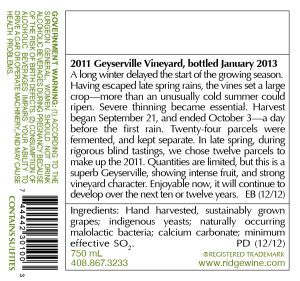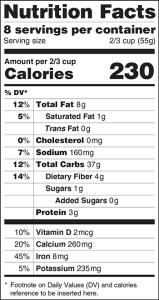Last year, I blogged several times about nutrition facts panels and ingredients statements in relation to wine and other TTB-regulated alcohol products. See A Regulatory Analysis: Nutrition Fact Panels and Ingredient Statements on Alcohol Beverages; Full Ingredients List to Appear on 2011 Ridge Vineyards Wine Label. As many know, for the majority of alcohol beverage products that fall within its labeling jurisdiction, the TTB does not require calorie counts, nutrition facts, or ingredients statements that are frequently seen on FDA-regulated food and beverage products. Such information is voluntary for TTB-regulated alcohol beverages.
Over the last few years, however, there’s been a trend in the amount of voluntary disclosure by producers of items like calories and ingredients. For example, last year Ridge Vineyards announced its 2011 vintage would feature a full disclosure of the wine’s ingredients as well as the actions followed to produce the wine. In other words, a food-styled ingredients list appeared on the labels of Ridge’s 2011 release. Ridge was not the first winery to release a full ingredients list on its wines, but Dave McIntyre speculated that Ridge’s ingredients statement might have a greater influence over the industry than other full disclosure labels (including those from Bonny Doon, as here and here, and Shinn Estate, as here and here). Finally, companies like Skinnygirl boast calorie counts on their back labels and entice the consumer to enjoy the product “without the guilt.”

Since then, the powerhouse MillerCoors very recently announced its adaptation of the first U.S. beer nutritional facts label on its Miller64 beer. See MillerCoors Adopts First U.S. Beer Nutritional Labeling. Scott Bussen, a marketing communications representative for MillerCoors, stated the company’s decision to include such on its Miller64 line stems from the company’s belief that adding a nutritional label is “right for [its] business and [its] consumers.” Id. The new labels are said to debut in mid-March. The COLA for Miller64, as of February 20, 2014, indicates that the cans will include the serving size, calorie count, carbohydrates, fat, and protein content.
Last week, the FDA proposed some significant changes to its nutrition facts label. See Nutrition Facts Label: Proposed Changes Aim to Better Inform Food Choices. The nutrition facts label that currently appears on the labels of FDA-regulated food products was born in 1993 with the mission to educate consumers about the nutrient, vitamin, and mineral contents of food products on the marketplace. (And, with its introduction, came over 900 pages in the Federal Register as to why such a panel was needed.) After a life of twenty years, the panel is about to take on some hearty alterations, the highlights of which are:
- A greater emphasis on calorie count (larger and bolder text);
- A line indicating the amount of “Added Sugars”;
- Removal of “Calories from Fat”;
- Greater prominence of the amount of servings per package;
- Updated serving size requirements;
- Updated Daily Values (which are used to calculate the Percent Daily Value, or % DV, on the label) of many nutrients;
- Moving the % DV of nutrients to the left-hand side of the label; and
- Requiring the label to disclose the amount of potassium and Vitamin D present (Vitamins A and C can be listed voluntarily).
Id. FDA cites matters such as the updated scientific evidence corresponding to obesity and heart disease, the change in how people eat, and an attempt to curb obesity as reasons for this cardinal change. FDA’s proposed rule appeared in the Federal Register on Monday, March 3, 2014. Public comments can be made through June 2, 2014.

These proposed changes are significant to a nutrition facts panel that has not seen many transformations in its twenty year history. But more specifically, they exhibit the agency’s clear awareness of how the food consumer market has changed since 1993: a desire to be an informed buyer of food products. For those consumers who do regularly check the nutrition facts panel of products they purchase, the panel provides greater insight to the packaged product. The separation between sugars and added sugars informs a potential purchaser of how much sugar is present in the product naturally—and just how much sugar is supplemented by processing or similar. Further, the enlarged calorie count is certainly eye-catching at the least, if not almost foreboding.
All of these significant proposed changes for food products leave us with two questions: Is TTB next? And how will FDA’s proposed nutrition label changes affect alcohol beverage labels? The answers to these questions are not so simple, and show the clear division of how the two agencies regulate products that fall within their labeling jurisdiction.
Last year I posed two questions through one of my posts:
Are we, as consumers, entering a time period where full ingredient disclosure on wine labels is influential to our purchases? Is there ever an instance where it is advantageous for a winemaker to tell a full story on a label?
The answer is this: it takes three to label an alcohol beverage product. Those three are, of course, the consumers, the producers, and the agency.
The changes to the FDA nutrition facts panel indicates a trend, over the last twenty years, for greater consumer awareness in the types of food consumed. Specifically, in the amount of calories consumed, the level of sugar intake, and a greater understanding of percent daily value. The shortage of nutrition labels on most alcohol beverage products does not, in any way, discount this trend. TTB has been pressured by a number of consumer groups over the last few years, encouraging the agency to to develop a standardized nutritional labeling policy to allow consumers to monitor calorie intake of alcohol beverages. See, e.g., Consumer Groups Push for Mandatory Alcohol Labeling. However, the overwhelming interests of other industry members, i.e., producers and the agency, may simply curtail these efforts.
In May of last year, TTB published a ruling, Voluntary Nutrient Content Statements in the Labeling and Advertising of Wines, Distilled Spirits, and Malt Beverages, after the Federal Trade Commission required Four Loko to apply to TTB for permission to post a nutrition facts panel on its products. See Voluntary Nutrient Content Statements in the Labeling and Advertising of Wines, Distilled Spirits, and Malt Beverages. The ruling was considered by many to be a “good step” in the direction of standardized nutrition and serving facts labeling, but the agency was still encouraged to produce a final rule and mandate nutritional labeling on all alcohol beverage products. Specifically:
A voluntary approach simply won’t assure that consumers are provided this important information on all alcoholic beverages they choose to consume. And a standardized serving facts label would help consumers more easily understand the information presented and be able to compare information across products and categories.
What’s In Your Drink? TTB Takes a Step Toward Alcohol Labeling. The new FDA proposed nutrition facts panels puts additional pressure on TTB to formulate a mandatory policy for its own nutrition labels. However, while the promotion of FDA’s new and improved panel will likely encourage TTB to address its own labeling, the agency is not yet at a point where nutrition facts panels will become mandatory elements of alcohol beverage labels. That being said, the time is still approaching.
If we were much closer to a point where consumers, producers, and the agency (here, TTB) were ready and prepared to tackle the nutrition facts panel question, it would be of great cost to the industry—aside from the obvious costs to producers to add such a panel to current products, the agency would also exhibit an exorbitant amount of costs given its pre-market approval requirement for alcohol beverage labels. There would need to be a significant “phase out” time period in the interim before the change over to mandatory nutritional labeling. Further to the point, when considering the nutrition facts panel and the alcohol industry, we must be mindful of the fact that the FDA does not have a pre-market approval system for food product labels whereas TTB requires pre-market approval for its beverage labels. The answer, very simply, amounts to this: if nutrition facts panels similar to those found on FDA products were to become mandatory elements of alcohol beverage labels, TTB does not have the resources at this time to review a full nutrition facts panel on label applications of beverage products and instead must develop a panel that conforms with its regulatory style. While (some) consumers may be ready, willing, and eager to enter a marketplace stocked with full disclosure of ingredients and/or nutrients on alcohol beverage products, a TTB-mandated panel will take many seasons to develop, let alone go into effect.
FDA’s progress does, however, serve as an additional advocate for mandatory nutritional labeling on alcohol beverage products. The food agency’s progress, combined with the great steps by industry members like MillerCoors, Skinnygirl, and Ridge Vineyards, are only proof that we are heading toward an age of full disclosure.
Photographs property of the Alcohol Tobacco Tax and Trade Bureau and the Food and Drug Administration, respectively.
For more information on wine or alcohol law, labeling, FDA, TTB, or nutrition fact panels, please contact Lindsey Zahn.
DISCLAIMER: This blog post is for general information purposes only, is not intended to constitute legal advice, and no attorney-client relationship results. Please consult your own attorney for legal advice.
Every Calorie counting diet for the most part has been a failure. Fats to some may be the most important factor on the label. If this spreads to alcoholic beverages people will assume the calorie contenet in wine is from Fat and it isn’t In fact the body cannot store the calories from alcohol it can only burn them. In a diabetic diet (where people do count fat) alcohol is considered a fat replacement only because the liver will process alcohol before it will fat. Alcohol is not fat and it is not a protein nor a carbohydrate neither. This is a perfect fit for the fascist style Hegelian Dialectic that this actually is in a very transparent manner. time to cut back on this business killing (especially small business) nonsense where information can be found out easily if one wishes even on their smart phone in the store while shopping. They are actually doing what is not needed or proven of any value and is just another deceptive governemnt ploy. It is time people wake up and realize governemnt is not doing anything for them and everything is cui bono.